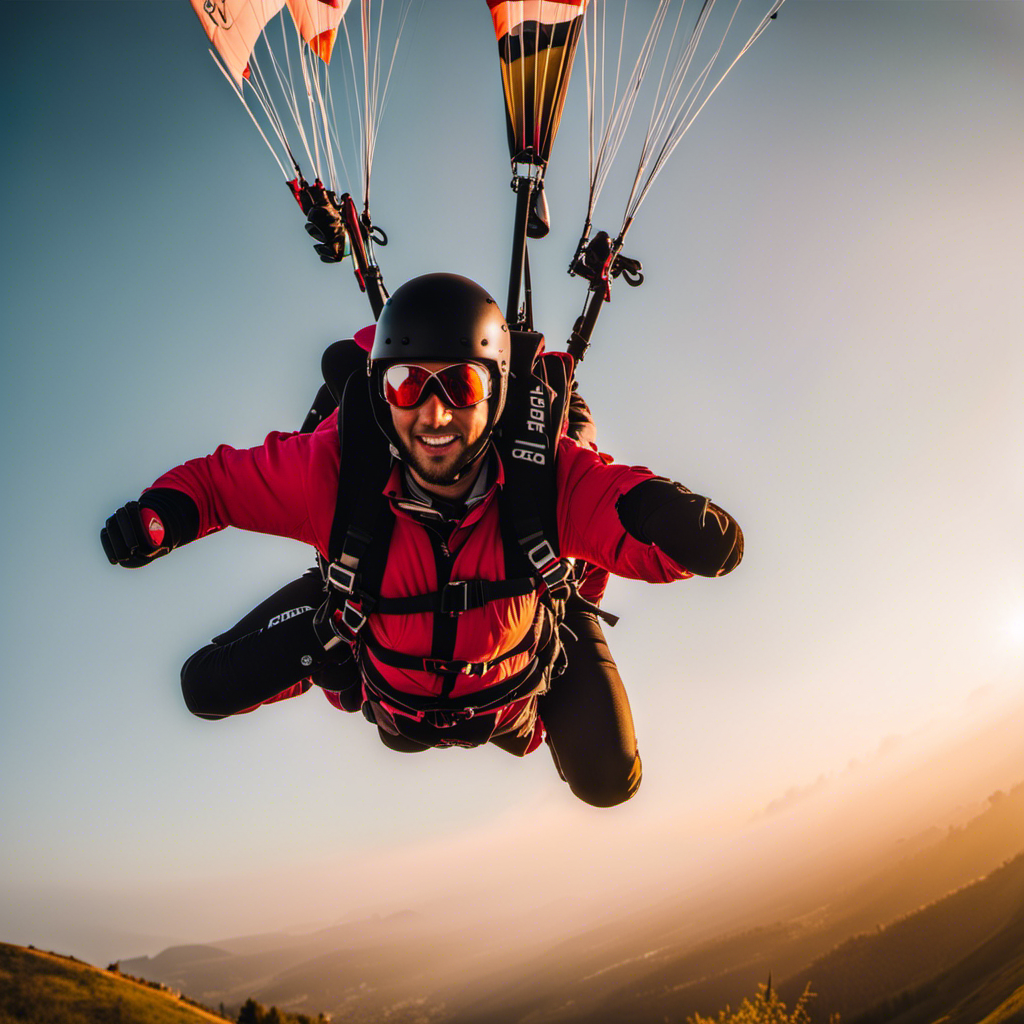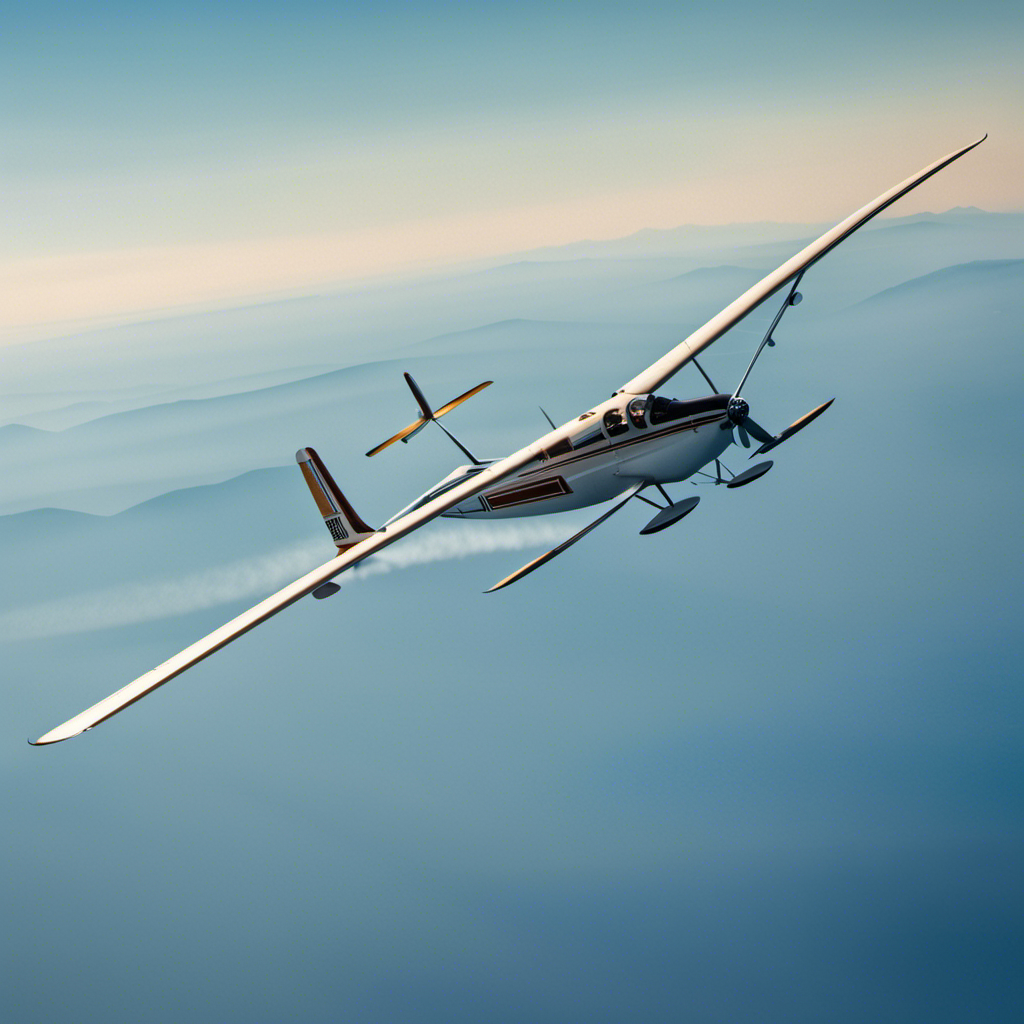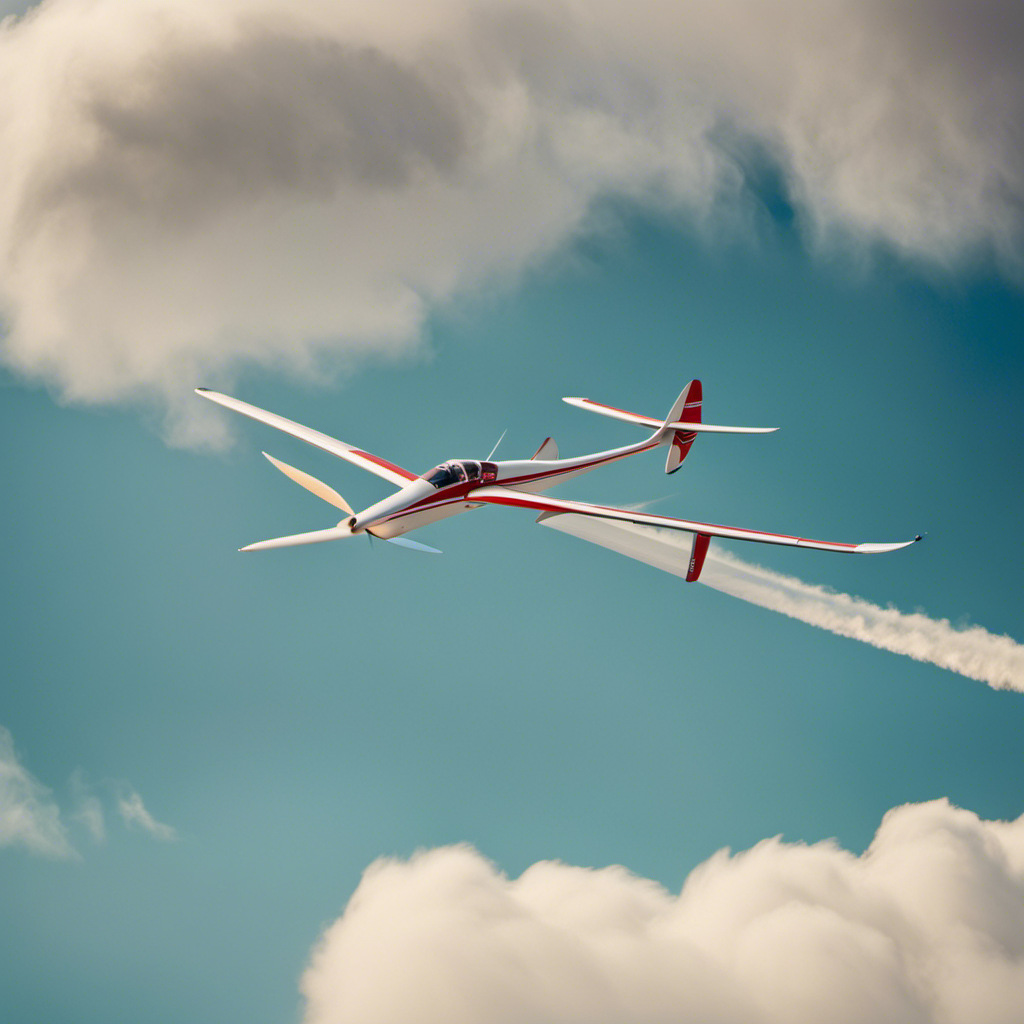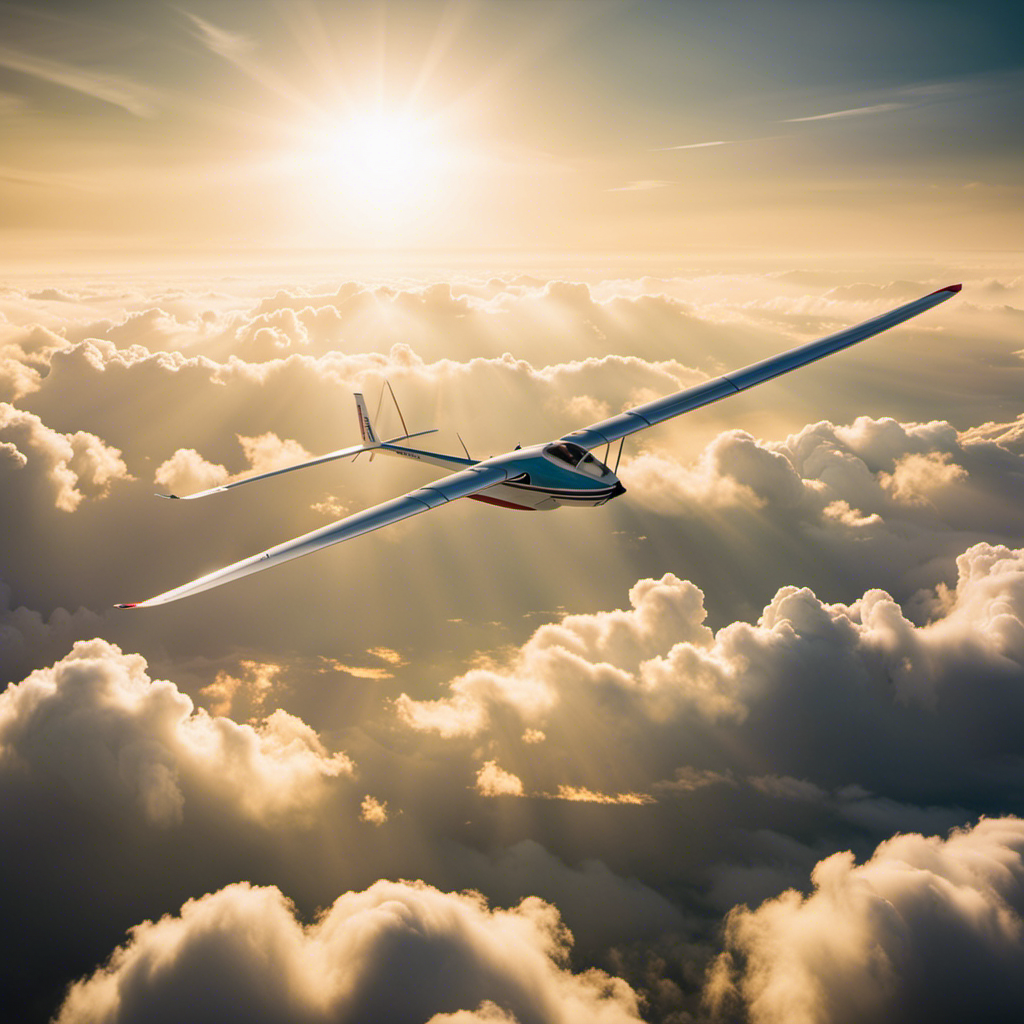Looking for the perfect wing design to enhance your glider’s performance? Look no further!
In this article, we’ll explore the ins and outs of various glider wing designs, from the Standard Wing to the High-Performance Wing, the Swept Wing to the Tapered Wing.
We’ll delve into the factors that influence wing selection, such as wing loading, flexibility, and material.
So buckle up and get ready to soar as we guide you in choosing the ultimate wing style for your glider.
Key Takeaways
- The wing style of a glider plays a significant role in its efficiency and maneuverability.
- Different wing styles offer various advantages and disadvantages, such as reduced drag in tapered wings, enhanced stability in swept wings, and balanced lift distribution in elliptical wings.
- The choice of wing style depends on specific needs and preferences, as well as the desired flight characteristics.
- Adding wingtip devices, such as winglets, wing fences, or wingtip sails, can further enhance the performance of a glider.
Understanding Glider Wing Designs
To understand glider wing designs, you’ll need to learn about different types of airfoils. An airfoil is the shape of the wing cross-section that helps generate lift and reduces drag.
The two main types of airfoils used in glider wings are the symmetrical and the cambered airfoil. A symmetrical airfoil has the same shape on the top and bottom, generating equal lift at zero angles of attack. On the other hand, a cambered airfoil has a curved shape, which creates more lift at positive angles of attack.
Each airfoil type has its advantages and disadvantages, affecting the glider’s performance and handling characteristics.
With this understanding, we can now move on to the standard wing, which is the most commonly used wing design in gliders.
The Standard Wing
If you want a wing that is commonly used and has a straightforward design, you should consider the standard wing. This wing style is widely popular among glider enthusiasts due to its reliability and ease of use. The standard wing features a simple straight wing shape with a constant chord and no tapering. Its design allows for easy construction and maintenance, making it a practical choice for many glider pilots.
The standard wing provides good stability and predictable flight characteristics, making it suitable for beginners and experienced pilots alike. However, if you are looking for a wing that offers higher performance and advanced features, the high-performance wing is worth considering. This wing type offers improvements in lift, speed, and maneuverability, allowing for a more thrilling and dynamic flying experience.
The High-Performance Wing
The high-performance wing offers increased lift, speed, and maneuverability, providing a more exciting and dynamic flying experience. Designed for advanced pilots seeking thrilling flights, this wing style incorporates cutting-edge aerodynamic features to enhance performance. With its sleek and streamlined shape, it reduces drag and increases lift, allowing for faster speeds and improved efficiency. The high-performance wing also features advanced control surfaces, such as flaps and ailerons, which enable precise maneuvers and responsive handling. To further illustrate the superiority of this wing style, consider the following table that compares the key characteristics of the high-performance wing with the standard wing:
| High-Performance Wing | Standard Wing | |
|---|---|---|
| Lift | Increased | Standard |
| Speed | Faster | Standard |
| Maneuverability | Enhanced | Standard |
| Aerodynamic Efficiency | Improved | Standard |
As you can see, the high-performance wing outperforms the standard wing in every aspect, providing an exhilarating flying experience. Now let’s explore the next section, which delves into the advantages of the swept wing design.
The Swept Wing
Designed for increased speed and improved efficiency, the swept wing incorporates advanced aerodynamic features. The swept wing is characterized by its backward orientation, where the wingtips are angled towards the rear of the aircraft. This unique design offers several advantages:
- Reduction of drag: The swept wing reduces the drag caused by the airflow over the wing, allowing for higher speeds.
- Delayed onset of compressibility: By delaying the onset of compressibility effects, such as shockwaves, the swept wing enables the aircraft to operate at higher speeds without encountering the negative effects of high-speed airflow.
- Improved maneuverability: The backward sweep of the wing enhances the aircraft’s ability to maneuver, making it more agile and responsive.
Transitioning into the subsequent section about the tapered wing, it is important to consider another wing design that further enhances the performance of gliders.
The Tapered Wing
Transitioning into the tapered wing, you can expect improved lift and reduced drag due to the wing’s gradual narrowing towards the wingtips. This unique design allows for a smooth airflow over the wing, resulting in increased efficiency and performance.
The tapered wing reduces the wingtip vortices, which are the swirling air masses that form at the wingtips and create drag. By minimizing these vortices, the tapered wing decreases drag, allowing the glider to maintain a higher speed for longer periods.
Additionally, the tapered wing provides better lift distribution, resulting in improved stability and maneuverability. This wing design is commonly used in high-performance gliders where maximizing efficiency is crucial.
Now, let’s delve into another wing style, the elliptical wing, known for its exceptional performance.
The Elliptical Wing
Moving on to the elliptical wing, you’ll find that this wing design offers exceptional performance due to its unique shape. Here are three reasons why the elliptical wing is a top choice for gliders:
-
Efficient Lift Distribution: The elliptical wing ensures a smooth distribution of lift along its span. This results in reduced induced drag, allowing the glider to fly with greater efficiency.
-
Reduced Wingtip Vortices: The elliptical shape minimizes the formation of wingtip vortices, which are swirling air masses that create drag. By reducing these vortices, the glider experiences less drag and improved overall performance.
-
Increased Maneuverability: The elliptical wing’s design provides better control and stability during maneuvers. Its balanced lift distribution allows for agile turns and precise control inputs, enhancing the pilot’s ability to navigate with ease.
Now, let’s delve into the wing loading factor and its impact on glider performance.
The Wing Loading Factor
The wing loading factor, or the amount of weight supported by each square foot of wing area, is a crucial factor in determining the overall performance of a glider. It directly affects the glider’s ability to climb, maneuver, and maintain stability in flight.
A higher wing loading factor means that each square foot of wing area must support more weight, resulting in increased wing loading and decreased lift efficiency. On the other hand, a lower wing loading factor allows for greater lift efficiency and improved glide performance.
To achieve optimal wing loading, glider designers must carefully consider the weight of the glider and the size of the wing area. This balance is essential to ensure that the glider can achieve the desired performance characteristics.
Transitioning into the subsequent section about wing flexibility and wingtip devices, the design of a glider’s wings also plays a significant role in its overall performance.
Wing Flexibility and Wingtip Devices
Wing flexibility and wingtip devices can greatly enhance the performance of a glider. When it comes to wing flexibility, there are a few key factors to consider.
-
Improved maneuverability: A flexible wing allows for better control and responsiveness, enabling you to navigate through the air with precision and ease.
-
Reduced drag: Flexibility helps to reduce drag by allowing the wing to adapt to varying flight conditions. This results in smoother airflow over the wing, minimizing turbulence and improving overall efficiency.
-
Increased lift: A flexible wing can generate more lift, enabling the glider to stay airborne for longer periods and potentially reach higher altitudes.
-
Enhanced safety: Wing flexibility can also improve safety by reducing the risk of structural failure or damage during turbulent flight or sudden maneuvers.
Considering these benefits, it becomes evident that wing flexibility is a crucial aspect to optimize in glider design.
Moving forward, let’s explore the importance of wing material and construction in achieving optimal performance.
Wing Material and Construction
When it comes to the construction of glider wings, there are various materials to choose from, each with their own unique properties. Factors such as weight, durability, and cost must be carefully considered in order to achieve optimal performance.
Different Materials Used in Glider Wing Construction
For your glider’s wing, you should consider using various materials to enhance its construction. The choice of materials can greatly impact the performance and durability of your glider. Here is a table showcasing different materials commonly used in glider wing construction:
| Material | Advantages | Disadvantages |
|---|---|---|
| Carbon Fiber | Lightweight, high strength, and stiffness | Expensive |
| Fiberglass | Affordable, good strength and durability | Heavier than carbon fiber |
| Balsa Wood | Lightweight, easy to work with | Not as strong as other materials |
| Foam | Lightweight, good insulation properties | Less durable than other materials |
| Aluminum | Strong and durable | Relatively heavy |
Considering factors such as weight, durability, and cost will help you make an informed decision when selecting the material for your glider’s wing. Each material has its own set of advantages and disadvantages, so it’s important to choose one that aligns with your specific needs and preferences.
Considering Factors such as Weight, Durability, and Cost
To make an informed decision about the material for your glider’s wing, you should consider factors such as weight, durability, and cost.
Weight is crucial because a lighter wing allows for better maneuverability and increased lift.
Durability ensures that your wing can withstand the stresses of flight and potential impacts.
Cost is also an important consideration, as it affects your overall budget for constructing the glider.
By carefully evaluating these factors, you can select a wing material that meets your specific needs and requirements.
Once you have determined the material, the next step is to choose the right wing style for your glider.
This involves considering factors such as wing shape, aspect ratio, and wing loading, which will be discussed in the following section.
Choosing the Right Wing Style for Your Glider
If you want optimal performance, you should consider the right wing style for your glider. The wing style plays a crucial role in determining the overall efficiency and maneuverability of your glider.
There are several wing styles to choose from, each with its own advantages and disadvantages. One popular option is the tapered wing, which gradually decreases in width from the root to the tip. This design reduces drag and improves the glider’s aerodynamic performance.
Another option is the swept wing, which angles backward from the root to the tip. This design is commonly found in high-speed gliders, as it enhances stability and reduces drag at high velocities.
Lastly, the elliptical wing is known for its excellent lift characteristics and smooth handling. It provides a balanced distribution of lift across the entire wing, resulting in precise control and efficient flight.
Consider your specific needs and preferences when choosing the right wing style for your glider to ensure optimal performance.
Frequently Asked Questions
How much does the wing design affect the overall performance of a glider?
The wing design significantly affects the overall performance of a glider. Factors such as wing shape, aspect ratio, and airfoil choice impact lift, drag, and maneuverability. Optimizing these design elements can greatly enhance a glider’s efficiency and handling capabilities.
Are there any safety considerations associated with specific wing styles?
When considering specific wing styles for a glider, it’s crucial to prioritize safety. Certain designs may affect the glider’s stability, maneuverability, and stall characteristics. Therefore, it’s essential to choose a wing style that aligns with the pilot’s skill level and intended use.
Can different wing styles be used interchangeably on the same glider?
Different wing styles can generally be used interchangeably on the same glider, as long as they are compatible with the glider’s design and intended use. Safety considerations should still be taken into account when selecting a wing style.
Are certain wing styles more suitable for specific weather conditions?
Certain wing styles are indeed more suitable for specific weather conditions. For example, a high aspect ratio wing is ideal for smooth, calm conditions, while a low aspect ratio wing performs better in turbulent or gusty conditions.
Is there a significant difference in cost between different wing styles?
The cost of different wing styles can vary significantly depending on factors such as materials used, manufacturing processes, and design complexity. It is important to consider cost alongside performance and suitability for specific weather conditions.
Conclusion
In conclusion, when it comes to choosing the best wing style for your glider, it all depends on your specific needs and preferences.
The standard wing is reliable and suitable for general flying, while the high-performance wing is ideal for advanced pilots seeking speed and agility.
The swept wing offers improved aerodynamic efficiency at high speeds, while the tapered wing provides better performance in thermals.
Consider the wing loading factor, wing flexibility, and wingtip devices to optimize your glider’s performance.
Remember, the right wing style is like finding the perfect harmony in flight, allowing you to soar with grace and finesse.
Orion, better known as “Jetstream,” is the voice that brings the stories of the skies to life. His fascination with aviation began at a young age, sparked by his father’s tales of flying and adventure. Orion’s journey into the world of gliding was serendipitous, and from the moment he took his first glider flight, he knew he had found his calling.










